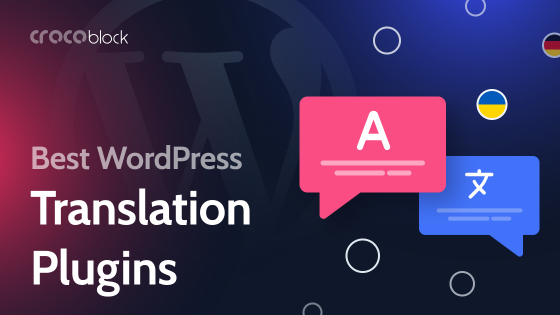Content is king. But what’s the point if nobody can read it, right?
That is why, for many developers who create a website for an audience from different countries, it is so important to choose the appropriate tool for translating text on the website. Of course, you can spend several dozen hours translating each word separately, but this option is only suitable if your site has a lot of content.
In this article, we will look at the functionality and features of using one of the most popular plugins for creating multilingual websites – the WPML WordPress plugin.
Table of Contents
- What Is the WPML Plugin?
- WPML Overview
- WPML Main Features
- WPML Pros and Cons
- WPML Pricing
- Using Crocoblock Plugins with WPML
- Multilingual Websites Built with Crocoblock and WPML
- WPML Alternatives
- FAQ
- In Conclusion
What Is the WPML Plugin?
WPML is a plugin that allows you to translate content on your website into 65 pre-configured languages. It helps translate not only articles or pages but also fields, menus, media, and custom post types. You can add your own language variants (like Canadian French or Mexican Spanish) using WPML’s languages editor. You don’t have to worry about being misunderstood, even if you’ve never learned, for example, Spanish.
WPML Overview
At first glance, WPML translation management and working with the plugin is very simple. After installation and activation, the system will ask you to configure the plugin and select languages:
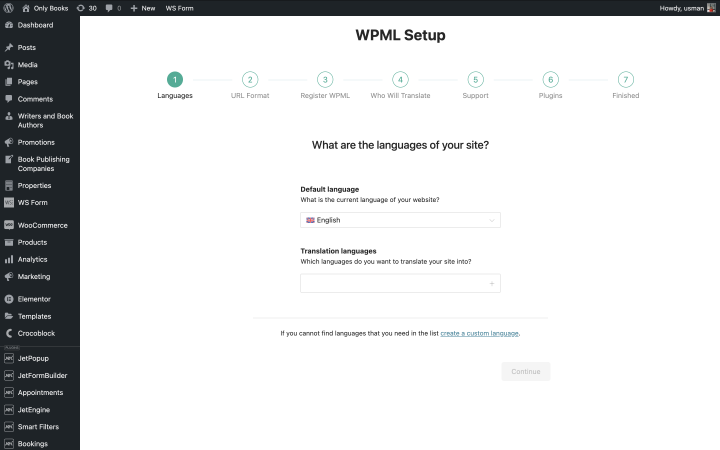
Next, the plugin will ask you to choose a URL format. Select the one that best suits your needs.
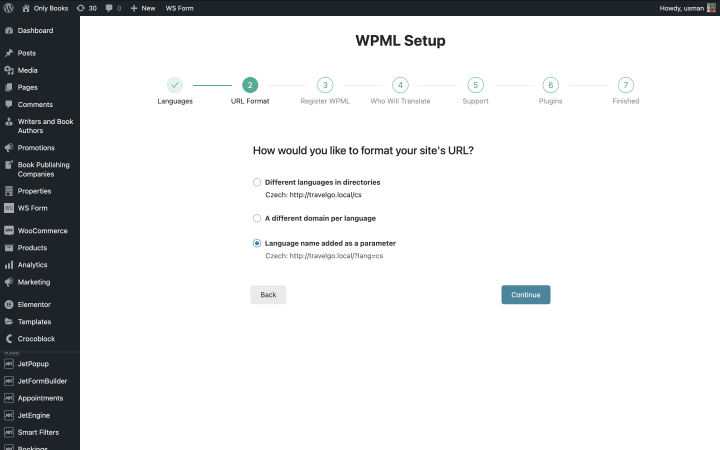
After registering your key, you can decide who will manage your website’s content.
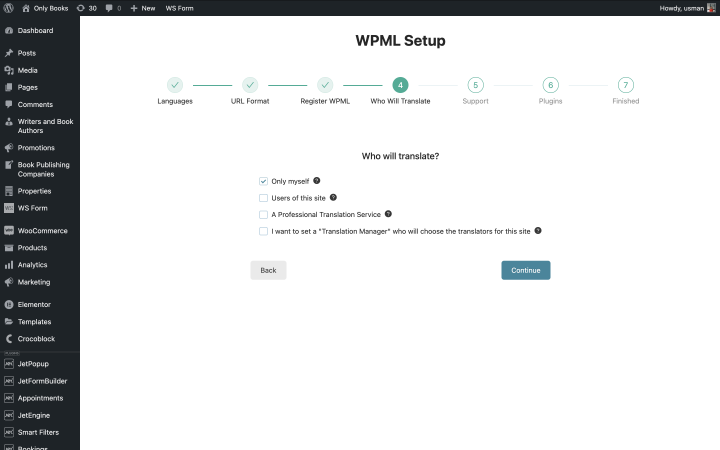
After completing the configurations, the WPML plugin will prompt you to install additional plugins for better website content translation. You can choose to install them or skip this step.
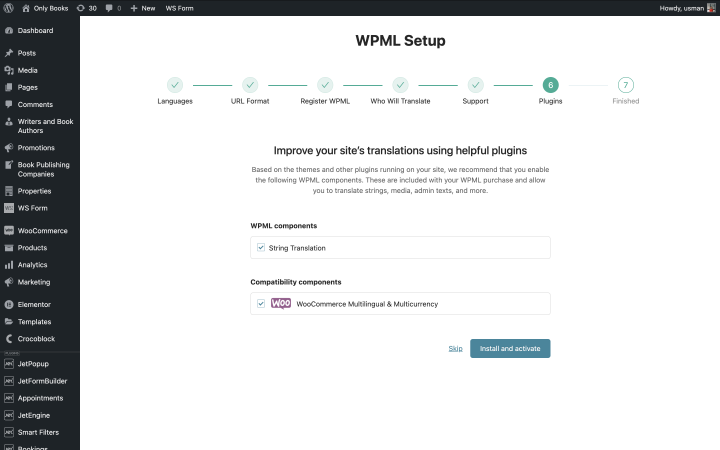
In just a few minutes, the WPML plugin will be activated and ready to use.
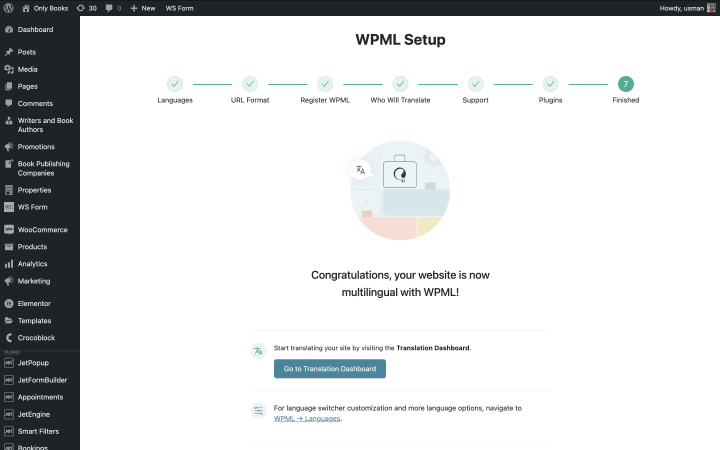
It is very convenient. You can proceed to translate pages manually, directly from the Dashboard if you already have them, start automatic translation, or combine both methods.
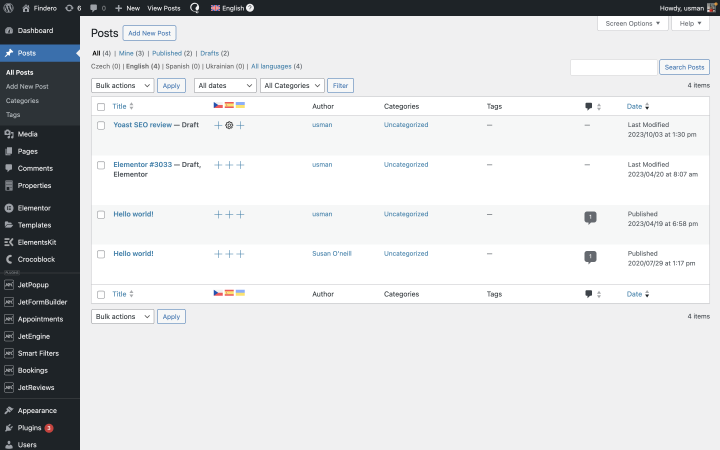
You can enable or disable auto-translation at any time. Once enabled, the plugin will let you choose between translating existing content or automatically translating new pages.

If you need automatic translation, the plugin offers two payment options for credits.
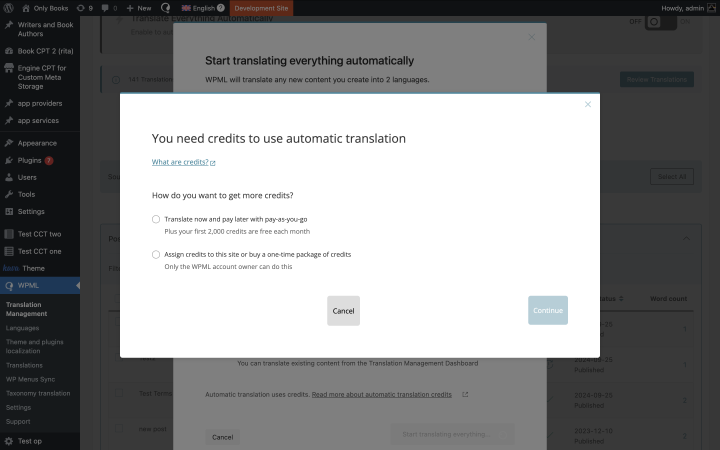
WPML Main Features
Let’s look at the main features of the WPML plugin.
Automatic translation
The automatic translation feature is convenient if you need to translate a large amount of text. It allows you to scan and edit any text during verification. In this mode, the plugin quickly and efficiently translates everything you place or update on the website.
The plugin helps translate custom post types, custom fields, widgets, menus, images, taxonomy terms, media, and even texts in the site’s admin.
Translation from translators
If, for some reason, you do not like automatic translation, you can do it yourself or use the services of professional translators. If you don’t know such specialists, you can find a suitable performer using the WPML Translation Jobs service.
Translation workflow control
You can control what is translated and how it’s translated. The plugin allows you to set up automatic translation for some content and manual translation for others.
Multilingual SEO
If your site has content for multilingual audiences, it makes sense to ensure it’s discoverable in search engines. However, creating identical keyword-rich content in different languages can be daunting and unnecessary. The WPML plugin helps optimize sites for other languages and automatically translates selected metadata.
Add-ons for every occasion
WPML plugin add-ons allow you to:
- translate WooCommerce site content, including product variations, emails, etc.;
- add a media gallery in different languages;
- make a string translation;
- use form plugins support (Contact Form 7, Ninja Forms, and Gravity Forms);
- integrate with Mailchimp, Yoast SEO, and Rank Math;
- use sticky links functionality.
WPML Pros and Cons
Pros
- easy to install and use;
- fast automatic translation of large amounts of text;
- support for 65+ languages;
- translated content is saved in the database even after the plugin is deactivated or deleted;
- functionality to mix machine and manual translation easily;
- a large number of add-ons for translating different types of content: widgets, WooCommerce content, filters, etc.;
- fully compatible with Crocoblock plugins;
- the plugin is fully AI-powered.
Cons
- automatic translation is not always accurate (however, the new WPML AI translation engine will give you results that are very close to “human quality”)
- can affect performance if there are many languages due to requests to the database (unlike some other SaaS-based plugins that use a dedicated CDN to store translations);
- support is provided mainly on the forum, but there is a live chat option that allows you to contact WPML support agents directly (when they are available).
The WPML WordPress plugin generally allows you to perform all content translation tasks on your website quickly and efficiently. Therefore, it is unsurprising that it is so popular among WordPress users.
WPML Pricing
The WPML plugin has several payment options due to its peculiarities.
First, you need to choose the option to purchase the plugin. If you need it for only one site and don’t plan to use automatic translation, this WPML package will cost €39 per year.
If you need it for up to 3 sites and want to translate a wide variety of content using automatic translation, you can choose the €99/year package. It includes the automatic translation feature, 90,000 translation credits, and 2,000 free credits monthly.
The third option is suitable for those who need to translate many sites. This option costs €199 per year and includes 180,000 credits for automatic translations.
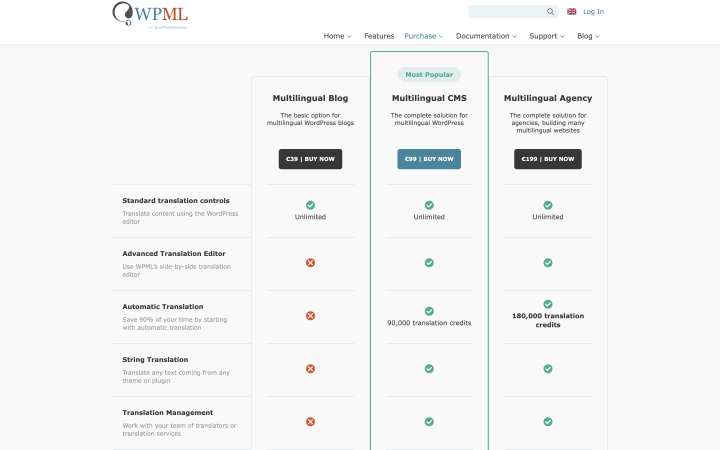
To translate your content, you must have credits in your account. Each word is worth a certain number of credits. For example, if you want your content to be translated automatically using DeepL, one of the most accurate translators, each word is worth two credits. If you prefer to use Google Translate for translations, each word will also cost two credits. And if you want a Microsoft translation, the cost will only be one credit per word.
Each option has a 30-day money-back guarantee.
You have several options if you don’t have enough credits in your package and want to translate more content automatically. For example, you can prepay and pay €50 for 40,000 credits or €180 for 200,000 credits. These prepaid credits have no time limit on usage.
You can also pay for translations as you use them per month (the “on-the-go” option). In this case, you get 2,000 free monthly credits; the following 8,000 cost €6. The price goes down for all subsequent ones.
Using Crocoblock Plugins with WPML
WPML is a strategic partner of Crocoblock, so the plugins are compatible and complement each other. As the WPML plugin is one of the most popular choices among our clients, any difficulties or problems are quickly addressed together.
If you want to create a dynamic multilingual website with JetEngine, use this tutorial.
To translate only filters created with JetSmartFilters, follow this tutorial. For search bar translation, refer to this one.
You can also translate content placed in widgets and entire WooCommerce pages.
Here are some comments from our community about the WPML plugin:
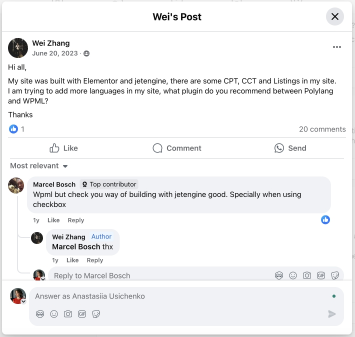
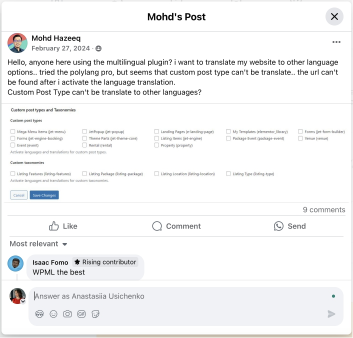
Multilingual Websites Built with Crocoblock and WPML
Let’s explore some fascinating websites created with Crocoblock and WPML.
Canada Homestay Network

The site is available in English and French, the two most commonly spoken languages in Canada.
By selecting a language at the top of the site, all content is automatically translated within seconds, making it highly convenient for users.
Quinta do Paral
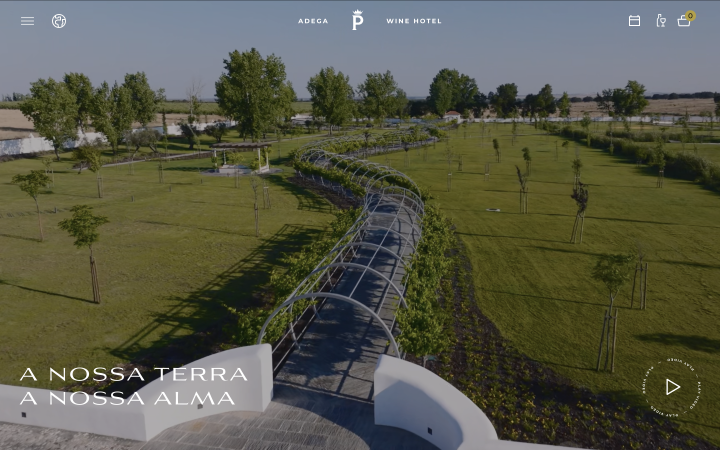
This website is dedicated to selling the winery’s products and offers the option to book a hotel located on the winery’s premises. The content can be translated into several languages, including Portuguese, English, and German.
By simply selecting a language, all content is automatically translated into the chosen language within seconds.
Sporting Pinamare
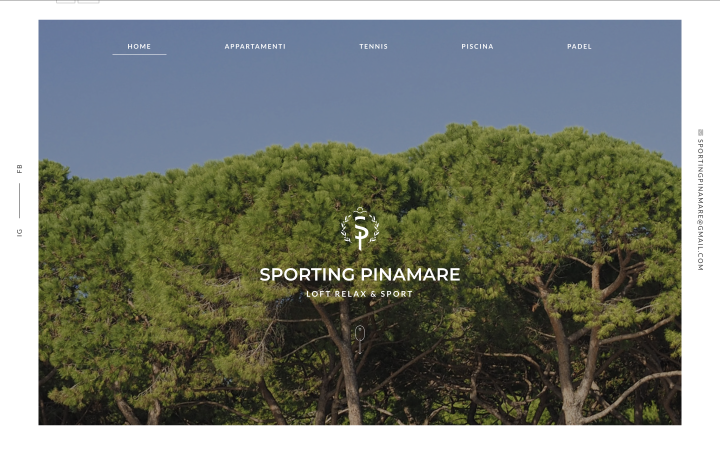
The Sporting Pinamare website allows visitors to book apartments and a variety of activities, including sports and sightseeing.
Located in Andorra, the site is available in Italian and English for the convenience of guests. Users can easily switch between languages using the menu at the top of the website.
H2Boat
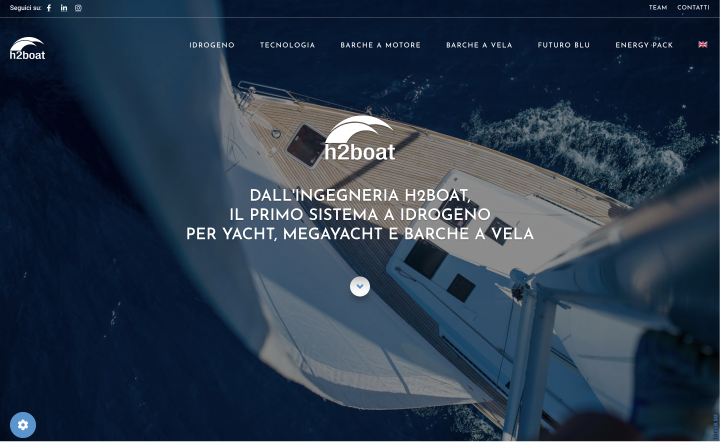
This site offers boat fuel made from hydrogen, which is environmentally friendly and completely safe for marine ecosystems.
The site features a language switch that automatically translates all information from Italian to English.
WPML Alternatives
Although WPML is the most popular translation plugin and has long held a monopoly, it now has competitors.
There is a comparison table on the plugin’s website where you can set your parameters and decide which plugin is suitable in your case:
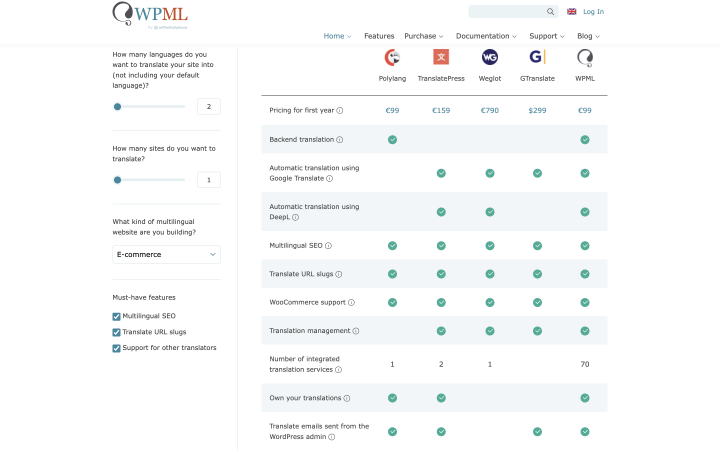
Here, I’ll look at a few translation plugins most often mentioned by users in our Crocoblock community.
Polylang
The Polylang plugin allows you to translate any content manually; it doesn’t have an automatic translation option like WPML. Therefore, it is suitable for small sites with not too much content.
You can place the translated site under a new slogan or subdomain. It’s not always convenient, but if you need translation to just one language, it won’t be a problem.
Polylang is a freemium plugin, and the paid version starts at €99.
Translate Press
Translate Press is a freemium plugin that supports 11 languages. It allows you to manually translate content on your WordPress site using a visual editor.
The free version has no automatic translation, which is inconvenient if you have a lot of dynamic content. But if your site is small, this option might work for you. Google Translate powers the automatic translation, so you must check your content carefully after translation. If you want to use DeepL for translation, which gives more accurate results, you can opt for the Business or Developer package, which costs €199 and €349 per year, respectively.
Weglot
Weglot is the most expensive but also the most convenient plugin for automatic translation among WPML competitors. By the way, we have a detailed review of this plugin.
Weglot allows you to make automatic translations into more than 100 languages using Microsoft, DeepL, and Google technologies. It translates all content on the site, including multimedia and dynamic content. The plugin is great for users with bulky sites with a lot of information.
The price starts at €15 and depends on the number of sites you need to translate and the website’s content.
FAQ
The most popular translation plugin is WPML. It allows you to do both automatic and manual translation. But if you don’t like this option and have a small website, you can use Polylang or Translate Press.
Yes. It enables the automatic translation of metadata into different languages when needed.
No. But you only pay for new translations; everything translated before is stored in your database.
Yes, it’s fully compatible with Crocoblock plugins like JetEngine, JetSmartFilters, JetSearch, JetWooBuilder, etc.
In Conclusion
Today, reaching a global audience is easier than ever. You can share your knowledge and information with people worldwide, regardless of their language. And it’s easy to do so, thanks to translation plugins.
Among all such plugins, the most popular one is WPML. It allows you to take control of the translation, do it automatically or manually, review each text, or publish it automatically. The WPML plugin will enable you to install add-ons to make every word understandable for any user, whether in a form, on a button, about a product, or in general site content.

